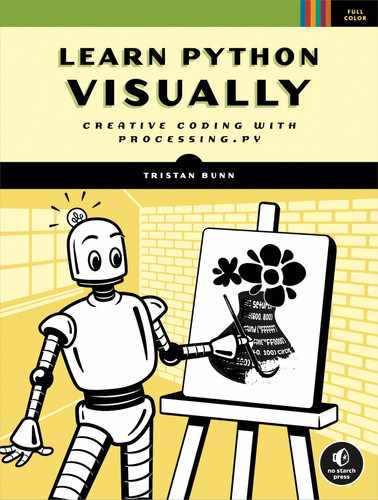This beginners book introduces non-programmers to the fundamentals of computer coding within a visual, arts-focused context. Tristan Bunn’s remarkably effective teaching approach is designed to help you visualize core programming concepts while you make cool pictures, animations, and simulations using Python Mode for the open-source Processing development environment. Right from the first chapter, you'll produce and manipulate colorful drawings, shapes and patterns as Bunn walks you through a series of easy-to-follow graphical coding projects that grow increasingly complex. You’ll go from drawing with code to animating a bouncing DVD screensaver and practicing data-visualization techniques. Along the way, you’ll encounter creative-yet-practical skill-building challenges that relate to everything from video games, cars, and coffee, to fine art, amoebas, and Pink Floyd. As you grow more fluent in both Python and programming in general, topics shift toward the mastery of algorithmic thinking, as you explore periodic motion, Lissajous curves, and using classes to create objects. You’ll learn about: •Basic coding theories and concepts, like variables, data types, pixel coordinates, control flow and algorithms In addition to giving you a good grounding in general programming, the skills and knowledge you’ll gain in this book are your entry point to coding for an ever-expanding horizon of creative technologies.
•Writing code that produces drawings, patterns, animations, data visualizations, user interfaces, and simulations
•Using conditional statements, iteration, randomness, lists and dictionaries
•Defining functions, reducing repetition, and making your code more modular
•How to write classes, and create objects to structure code more efficiently
Table of Contents
- Title Page
- Copyright
- About the Author
- Acknowledgments
- Introduction
- Chapter 1: Hello, World!
- Chapter 2: Drawing More Complicated Shapes
- Displaying a Grid
- Drawing Curves Using Catmull-Rom Splines
- Curving Lines with curve()
- Changing Curves with curveTightness()
- Drawing Bézier Curves
- Using the bezier() Function
- Positioning Anchor and Control Points
- Drawing Shapes Using Vertices
- Bézier Vertices
- Using Vector Graphics Software for Generating Shapes
- Summary
- Chapter 3: Introduction to Strings and Working with Text
- Chapter 4: Conditional Statements
- Chapter 5: Iteration and Randomness
- Chapter 6: Motion and Transformation
- Chapter 7: Working with Lists and Reading Data
- Chapter 8: Dictionaries and JSON
- Chapter 9: Functions and Periodic Motion
- Defining Functions
- Creating a Simple Speech Bubble Function
- Drawing Compound Shapes Using a Function
- Adding Arguments and Parameters
- Using Keyword Arguments
- Setting Default Values
- Mixing Positional and Keyword Arguments
- Returning Values
- Defining Functions for Periodic Motion
- Circular and Elliptical Motion
- Sine Waves
- Lissajous Curves
- Creating Screensaver-Like Patterns with Lissajous Curves
- Summary
- Chapter 10: Object-Oriented Programming and PVector
- Working with Classes
- Defining a New Class
- Creating an Instance from a Class
- Adding Attributes to a Class
- Adding Methods to a Class
- Splitting Your Python Code into Multiple Files
- Programming Movement with Vectors
- The PVector Class
- Moving an Amoeba with PVector
- Adding Many Amoebas to the Simulation
- Summary
- Chapter 11: Mouse and Keyboard Interaction
- Afterword
- Index
